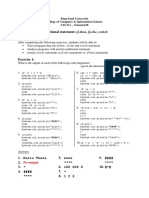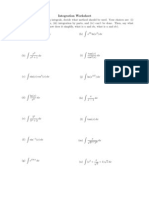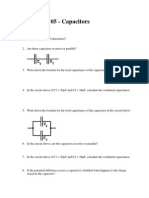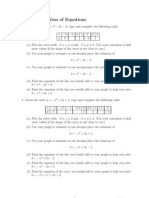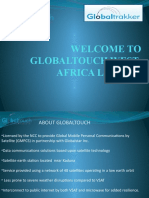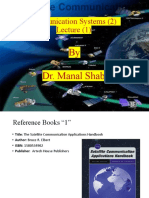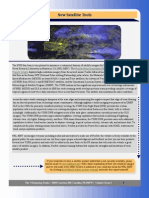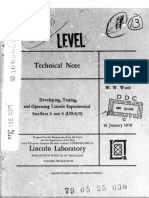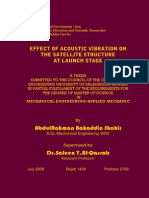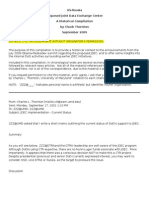Worksheet 19
Worksheet 19
Uploaded by
etud3clCopyright:
Available Formats
Worksheet 19
Worksheet 19
Uploaded by
etud3clCopyright
Available Formats
Share this document
Did you find this document useful?
Is this content inappropriate?
Copyright:
Available Formats
Worksheet 19
Worksheet 19
Uploaded by
etud3clCopyright:
Available Formats
19 Worksheet (A2)
Data needed to answer questions can be found in the Data, formulae and relationships sheet. 1 2 3 4 Define gravitational field strength at a point in space. Show that the gravitational constant G has the unit N m2 kg2. The gravitational field strength on the surface of the Moon is 1.6 N kg1. What is the weight of an astronaut of mass 80 kg standing on the surface of the Moon? Calculate the magnitude of the gravitational force between the objects described below. You may assume that the objects are point masses. a two protons separated by a distance of 5.0 1014 m (mass of a proton = 1.7 1027 kg) [3] [1] [2] [2]
b two binary stars, each of mass 5.0 1028 kg, with a separation of 8.0 1012 m
[2]
two 1500 kg elephants separated by a distance of 5.0 m
[2]
The diagram shows the Moon and an artificial satellite orbiting round the Earth. The radius of the Earth is R.
Write an equation for the gravitational field strength g at a distance r from the centre of an isolated object of mass M. b By what factor would the gravitational field decrease if the distance from the centre of the mass were doubled? c The satellite orbits at a distance of 5R from the Earths centre and the Moon is at a distance of 59R. Calculate the ratio: gravitational field strength at position of satellite gravitational field strength at position of Moon a 6 The planet Neptune has a mass of 1.0 1026 kg and a radius of 2.2 107 m. Calculate the surface gravitational field strength of Neptune.
[1] [2]
[3]
[3]
AS and A Level Physics
Original material Cambridge University Press 2010
19 Worksheet (A2)
7 Calculate the radius of Pluto, given its mass is 5.0 1023 kg and its surface gravitational field strength has been estimated to be 4.0 N kg1. 8 A space probe of mass 1800 kg is travelling from Earth to the planet Mars. The space probe is midway between the planets. Use the data given to calculate: a the gravitational force on the space probe due to the Earth b the gravitational force on the space probe due to Mars c the acceleration of the probe due to the gravitational force acting on it.
Data
[3]
[3] [2] [3]
separation between Earth and Mars = 7.8 1010 m mass of Earth = 6.0 1024 kg mass of Mars = 6.4 1023 kg
9 An artificial satellite orbits the Earth at a height of 400 km above its surface. The satellite has a mass 5000 kg, the radius of the Earth is 6400 km and the mass of the Earth is 6.0 1024 kg. For this satellite, calculate: a the gravitational force experienced b its centripetal acceleration c its orbital speed. 10 a Explain what is meant by the term gravitational potential at a point. b Write down the gravitational potential energy of a body of mass 1 kg when it is at an infinite distance from another body. c The radius of the Earth is 6.4 106 m and the mass of the Earth = 6.0 1024 kg. Calculate the potential energy of the 1 kg mass at the Earths surface. d Write down the minimum energy required to remove the body totally from the Earths gravitational field. 11 The planets in our solar system orbit the Sun in almost circular orbits. a Show that the orbital speed v of a planet at a distance r from the centre of the Sun is given by: GM v= r b The mean distance between the Sun and the Earth is 1.5 1011 m and the mass of the Sun is 2.0 1030 kg. Calculate the orbital speed of the Earth as it travels round the Sun. 12 There is a point between the Earth and the Moon where the net gravitational field strength is zero. At this point the Earths gravitational field strength is equal in magnitude but opposite in direction to the gravitational field strength of the Moon. Given that: mass of Earth = 81 mass of Moon calculate how far this point is from the centre of the Moon in terms of R, where R is the separation between the centres of the Earth and the Moon. Total: Score:
[3] [2] [3] [2] [1] [3] [1]
[4]
[2]
[4] %
57
AS and A Level Physics
Original material Cambridge University Press 2010
You might also like
- The Subtle Art of Not Giving a F*ck: A Counterintuitive Approach to Living a Good LifeFrom EverandThe Subtle Art of Not Giving a F*ck: A Counterintuitive Approach to Living a Good LifeRating: 4 out of 5 stars4/5 (5991)
- The Gifts of Imperfection: Let Go of Who You Think You're Supposed to Be and Embrace Who You AreFrom EverandThe Gifts of Imperfection: Let Go of Who You Think You're Supposed to Be and Embrace Who You AreRating: 4 out of 5 stars4/5 (1112)
- Never Split the Difference: Negotiating As If Your Life Depended On ItFrom EverandNever Split the Difference: Negotiating As If Your Life Depended On ItRating: 4.5 out of 5 stars4.5/5 (899)
- Hidden Figures: The American Dream and the Untold Story of the Black Women Mathematicians Who Helped Win the Space RaceFrom EverandHidden Figures: The American Dream and the Untold Story of the Black Women Mathematicians Who Helped Win the Space RaceRating: 4 out of 5 stars4/5 (932)
- Grit: The Power of Passion and PerseveranceFrom EverandGrit: The Power of Passion and PerseveranceRating: 4 out of 5 stars4/5 (619)
- Shoe Dog: A Memoir by the Creator of NikeFrom EverandShoe Dog: A Memoir by the Creator of NikeRating: 4.5 out of 5 stars4.5/5 (546)
- The Hard Thing About Hard Things: Building a Business When There Are No Easy AnswersFrom EverandThe Hard Thing About Hard Things: Building a Business When There Are No Easy AnswersRating: 4.5 out of 5 stars4.5/5 (357)
- Her Body and Other Parties: StoriesFrom EverandHer Body and Other Parties: StoriesRating: 4 out of 5 stars4/5 (831)
- Elon Musk: Tesla, SpaceX, and the Quest for a Fantastic FutureFrom EverandElon Musk: Tesla, SpaceX, and the Quest for a Fantastic FutureRating: 4.5 out of 5 stars4.5/5 (477)
- The Emperor of All Maladies: A Biography of CancerFrom EverandThe Emperor of All Maladies: A Biography of CancerRating: 4.5 out of 5 stars4.5/5 (275)
- The Little Book of Hygge: Danish Secrets to Happy LivingFrom EverandThe Little Book of Hygge: Danish Secrets to Happy LivingRating: 3.5 out of 5 stars3.5/5 (426)
- The World Is Flat 3.0: A Brief History of the Twenty-first CenturyFrom EverandThe World Is Flat 3.0: A Brief History of the Twenty-first CenturyRating: 3.5 out of 5 stars3.5/5 (2281)
- The Yellow House: A Memoir (2019 National Book Award Winner)From EverandThe Yellow House: A Memoir (2019 National Book Award Winner)Rating: 4 out of 5 stars4/5 (99)
- The Sympathizer: A Novel (Pulitzer Prize for Fiction)From EverandThe Sympathizer: A Novel (Pulitzer Prize for Fiction)Rating: 4.5 out of 5 stars4.5/5 (125)
- Devil in the Grove: Thurgood Marshall, the Groveland Boys, and the Dawn of a New AmericaFrom EverandDevil in the Grove: Thurgood Marshall, the Groveland Boys, and the Dawn of a New AmericaRating: 4.5 out of 5 stars4.5/5 (270)
- A Heartbreaking Work Of Staggering Genius: A Memoir Based on a True StoryFrom EverandA Heartbreaking Work Of Staggering Genius: A Memoir Based on a True StoryRating: 3.5 out of 5 stars3.5/5 (232)
- Team of Rivals: The Political Genius of Abraham LincolnFrom EverandTeam of Rivals: The Political Genius of Abraham LincolnRating: 4.5 out of 5 stars4.5/5 (235)
- On Fire: The (Burning) Case for a Green New DealFrom EverandOn Fire: The (Burning) Case for a Green New DealRating: 4 out of 5 stars4/5 (75)
- Gold Trading StrategyDocument1 pageGold Trading Strategyetud3clNo ratings yet
- Sec 3 Chemistry Practice QuestionsDocument4 pagesSec 3 Chemistry Practice Questionschong56100% (1)
- The Unwinding: An Inner History of the New AmericaFrom EverandThe Unwinding: An Inner History of the New AmericaRating: 4 out of 5 stars4/5 (45)
- Postek C168 Series User's Manual PDFDocument45 pagesPostek C168 Series User's Manual PDFetud3clNo ratings yet
- BNBR Q1 2019 PDFDocument129 pagesBNBR Q1 2019 PDFetud3clNo ratings yet
- Netis Price List Aug 2017Document2 pagesNetis Price List Aug 2017etud3clNo ratings yet
- Blibli All CategoriesDocument97 pagesBlibli All Categoriesetud3clNo ratings yet
- Mc36 Specification SheetDocument2 pagesMc36 Specification Sheetetud3clNo ratings yet
- Number 7.3 - Direct Proportion 10 in 10Document1 pageNumber 7.3 - Direct Proportion 10 in 10etud3clNo ratings yet
- Conditional Statement: If-Then, If-Else, SwitchDocument4 pagesConditional Statement: If-Then, If-Else, Switchetud3clNo ratings yet
- Cinema 3D Monitor: Owner'S ManualDocument28 pagesCinema 3D Monitor: Owner'S Manualetud3clNo ratings yet
- U12 Rev Ws - 10 - No Ice or KSPDocument3 pagesU12 Rev Ws - 10 - No Ice or KSPetud3clNo ratings yet
- Digital Timer Switch Ax300 Manual BookDocument10 pagesDigital Timer Switch Ax300 Manual Booketud3clNo ratings yet
- Integration WorksheetDocument1 pageIntegration Worksheetetud3clNo ratings yet
- A180X ManualDocument1 pageA180X Manualetud3clNo ratings yet
- U12 Rev Ws - 10 - No Ice or KSPDocument3 pagesU12 Rev Ws - 10 - No Ice or KSPetud3clNo ratings yet
- 2012chem1 WchemistryDocument38 pages2012chem1 WchemistrySilence ForteNo ratings yet
- Related RatesDocument8 pagesRelated Ratesetud3clNo ratings yet
- Algebra 2 ProbabilityDocument10 pagesAlgebra 2 Probabilityetud3clNo ratings yet
- 1112 1mathsw00Document12 pages1112 1mathsw00Jessica AmandaNo ratings yet
- Checklist For Superposition Effect: I HaveDocument1 pageChecklist For Superposition Effect: I Haveetud3clNo ratings yet
- Word Prob Multiplication 12Document1 pageWord Prob Multiplication 12etud3clNo ratings yet
- Ws 13 S 09 KeyDocument7 pagesWs 13 S 09 Keyetud3cl100% (1)
- Worksheet - 05 - Capacitors: NameDocument3 pagesWorksheet - 05 - Capacitors: Nameetud3clNo ratings yet
- 4th Graphical Solution of EquationsDocument2 pages4th Graphical Solution of Equationsetud3clNo ratings yet
- Robert M Pimpsner - Orbital Debris Mitigation - ENS 100Document18 pagesRobert M Pimpsner - Orbital Debris Mitigation - ENS 100RobertMPimpsnerNo ratings yet
- And Nutrition For The Space Station: Food ServiceDocument103 pagesAnd Nutrition For The Space Station: Food ServiceGruff GrufferNo ratings yet
- Day 2 Enp Genodia 01 Mapping TechnologiesDocument108 pagesDay 2 Enp Genodia 01 Mapping TechnologiesEdward Aguirre PingoyNo ratings yet
- Welcome To Globaltouch West Africa LimitedDocument19 pagesWelcome To Globaltouch West Africa LimitedDyaji Charles BalaNo ratings yet
- DTH Set Top Box Installation & Service TechnicianDocument146 pagesDTH Set Top Box Installation & Service TechnicianharivigneshaNo ratings yet
- Introduction To Satellite Constellations: Orbital Types, Uses and Related FactsDocument39 pagesIntroduction To Satellite Constellations: Orbital Types, Uses and Related FactsAndré LuizNo ratings yet
- Radiation Handbook For ElectronicsDocument118 pagesRadiation Handbook For ElectronicsSaqib Ali Khan100% (1)
- Key - Corrections of The ExercisesDocument9 pagesKey - Corrections of The ExercisesSara SpanoNo ratings yet
- Lec1 Satellite - Lec1Document47 pagesLec1 Satellite - Lec1Manal ShabanNo ratings yet
- Structure SatelliteDocument26 pagesStructure SatelliteorlandoNo ratings yet
- New Satellite Tools - The Whispering TradesDocument1 pageNew Satellite Tools - The Whispering TradesU.S. Naval Research LaboratoryNo ratings yet
- Reading Materials For MKUBInggrisDocument7 pagesReading Materials For MKUBInggrisZul FahmiNo ratings yet
- ADA069095Document88 pagesADA069095rmilhomemNo ratings yet
- Effect of Acoustic Vibration On The Satellite Structure at Launch StageDocument146 pagesEffect of Acoustic Vibration On The Satellite Structure at Launch StageAbsaACNo ratings yet
- AffcaseDocument20 pagesAffcaseherbertNo ratings yet
- Sample Technical Description: Cleveland State UniversityDocument4 pagesSample Technical Description: Cleveland State UniversityImran AslamNo ratings yet
- Thornton - JDEC History - The US-Russia Joint Data Exchange CenterDocument17 pagesThornton - JDEC History - The US-Russia Joint Data Exchange CenterChuck ThorntonNo ratings yet
- İngilizce Paragraf Çalışmaları LYS-5 Ve YDS-6Document3 pagesİngilizce Paragraf Çalışmaları LYS-5 Ve YDS-6Osman GüneşNo ratings yet
- Notes in Inmarsat and SignalsDocument9 pagesNotes in Inmarsat and Signalsnirala6No ratings yet
- Satellite Basics VSAT PDFDocument21 pagesSatellite Basics VSAT PDFcrispix2000No ratings yet
- Defense Against The Dark Arts in SpaceDocument53 pagesDefense Against The Dark Arts in SpacebenmousarihabNo ratings yet
- A Cylindrical Shadow Eclipse Prediction Model For LEO Satellites With Application To IRS SatellitesDocument14 pagesA Cylindrical Shadow Eclipse Prediction Model For LEO Satellites With Application To IRS SatellitesAsia Pacific Journal of Engineering Science and TechnologyNo ratings yet
- Gravitational Forces and FieldsDocument3 pagesGravitational Forces and FieldsPathmanathan Nadeson0% (2)
- AFIRS 220 Operations ManualDocument103 pagesAFIRS 220 Operations ManualErnesto Javier Acuña CanoNo ratings yet
- sc-1000Document2 pagessc-1000emailmehere095No ratings yet
- Remembering The Space AgeDocument480 pagesRemembering The Space AgeJosé Galisi Filho100% (1)
- 2024 LASC Satellite Challenge Standards Manual R01Document49 pages2024 LASC Satellite Challenge Standards Manual R01david.arruda99No ratings yet
- UNIT10 Travel SpaceDocument9 pagesUNIT10 Travel SpaceRaphaël DurandNo ratings yet
- Alos Palsar: Technical Outline and Mission ConceptsDocument7 pagesAlos Palsar: Technical Outline and Mission ConceptsNyeinchan MinNo ratings yet
- AERO4701 Assignment 1Document4 pagesAERO4701 Assignment 1Ryan ZhangNo ratings yet
















































